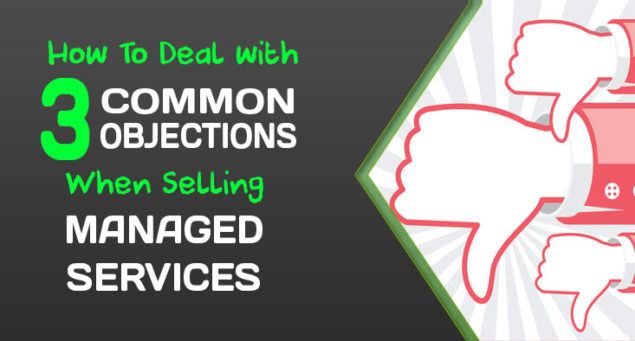- You are here:
- Home »
- Blog »
- MSP Sales »
- How to Deal with Three Common Objections When Selling Managed Services

How to Deal with Three Common Objections When Selling Managed Services
“We’re okay with the way things work right now.”
Hearing objections from your prospects can be scary and nerve-racking. Objections can turn your sales pitch into a dead end if you aren’t prepared. But these are also a way for your prospective clients to say they are interested but need more information. And when you tell them what they need to know, you are helping your prospects better understand the value of your solution. So the key into handling objections successfully is anticipating it beforehand.
Here are three common objections that you can prepare for.
We Don’t Need It
Your business customers could have different ideas of what services they should have from you. They think they understand their technology needs, but what they know may be outdated. But telling your clients they don’t know what they really need is not the best thing to do.
There is no single IT solution that fits all businesses. Each company’s IT situation is unique and it’s up to you to uncover the IT issues they have. This is an opportunity to present how your managed service can address those problems. But be careful not to give the impression that you’re just an upgraded replica of your competition. If you go down this road, your prospect will think you’re just another dispensable commodity, and you could be forced to lower your prices.
If it’s a long-time business client, then differentiate your break-fix from your managed service. Focus your presentation on what’s different and its benefits. You can list down the differences such as:
- automatic and regular application of security updates
- a monthly report that details status of the network and recommendations
- includes any desktop jobs for operating system or existing software
- free IT consultation meetings once month
You should include in your list everything that your managed service covers. Your goal is to make your client realize what they don’t have. Of course, you should let your prospects come to their own conclusion. But you can use the needed tools to convince your prospects that they need your services now.
Our IT is Fine
Business customers have a different idea of what fine is. When they use that term they mean that servers aren’t crashing and their IT vendor calls them back if they have a problem. But to MSPs, the term fine means providing a predictable IT performance. That’s a large contrast to having to react to every IT problem that comes along.
When your business customer has a complacent attitude, you can try to use just a touch of fear to move them into action. This is to get the client to see why there is a need to start thinking about making the necessary changes. Are they prepared for a ransomware attack? Do they have the right tools for business continuity? Can they recover quickly in case of a disaster? Present your managed service to your prospects as the practical solution.
You can also share some research about the competition and some of the changes they have made. Giving your prospects a glimpse of what they lack from their competitors can give them the incentive to consider your proposal.
We’re Paying Less Than That
When price is the biggest hurdle for a client, then you are expected to justify the cost of your service. If possible, try breaking down your total cost into smaller amounts that are attached to smaller services. And make sure you focus on the unique value of your products and services that the client won’t be able to get from any other provider.
You can also point out the lost revenue during downtime. This is at the heart of managed service, because it can predict a possible hardware failure looming on the horizon.
But remember, forcing customers to buy from you is never a good idea. Get as clear as you can on the objection and try to determine what your prospect is really concerned about. As a rule of thumb, if your prospect says an objection twice, it’s real. So take time to study, refine, and practice your answers to sales objections. In time it will come naturally and your response will put your prospect at ease. And it can be a positive outcome.
